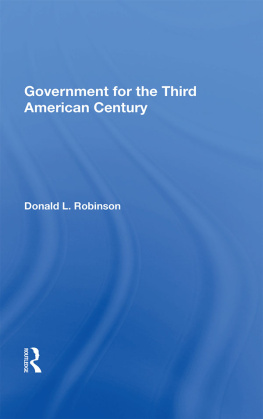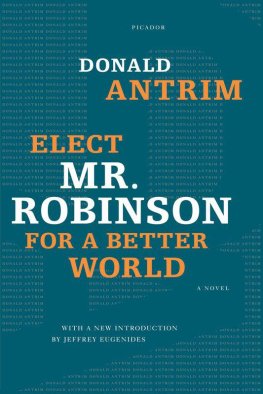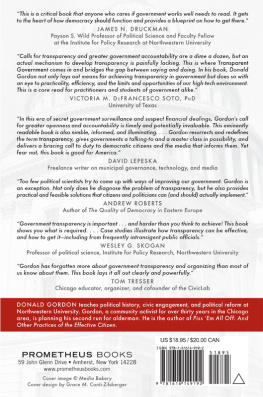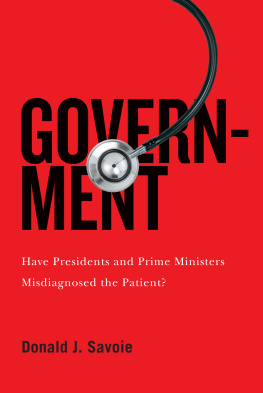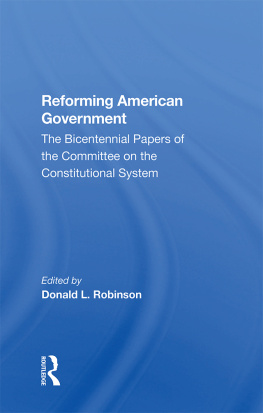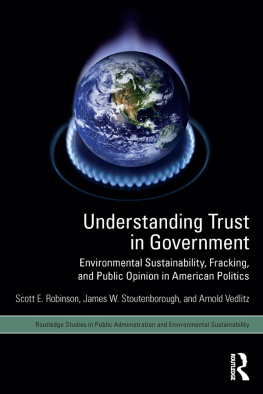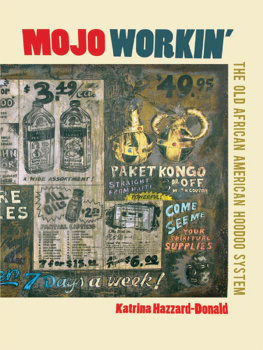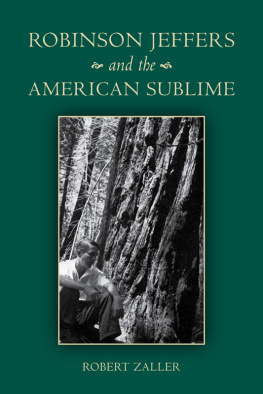Government for the Third American Century
First published 1989 by Westview Press
Published 2018 by Routledge
52 Vanderbilt Avenue, New York, NY 10017
2 Park Square, Milton Park, Abingdon, Oxon OX14 4RN
Routledge is an imprint of the Taylor & Francis Group, an informa business
Copyright 1989 by the Committee on the Constitutional System
All rights reserved. No part of this book may be reprinted or reproduced or utilised in any form or by any electronic, mechanical, or other means, now known or hereafter invented, including photocopying and recording, or in any information storage or retrieval system, without permission in writing from the publishers.
Notice:
Product or corporate names may be trademarks or registered trademarks, and are used only for identification and explanation without intent to infringe.
Library of Congress Cataloging-in-Publication Data
Robinson, Donald L., 1936-
Government for the Third American Century/by Donald L.
Robinson.
p. cm.
Includes bibliographical references.
ISBN 0-8133-0936-0. ISBN 0-8133-0935-2 (pbk.)
1. United StatesPolitics and government1945 I. Title.
JK271.R5355 1989
320.973dc20
89-36439
CIP
ISBN 13: 978-0-367-00361-6 (hbk)
To my students at Smith College, for demonstrating that citizens can recover the ability to think constitutionally
Contents
, Lloyd N. Cutler, C. Douglas Dillon, and Nancy Landon Kassebaum
PART ONE
SIGNS OF STRAIN: THE PERFORMANCE OF THE AMERICAN SYSTEM, 1950-1990
PART TWO
DO WE NEED STRUCTURAL REFORM? PRO AND CON
PART THREE
SPECIFIC PROPOSALS
PART FOUR
HOW TO PROCEED
Guide
As the Constitution enters its third century, we are witnessing what appears to be a polar shift in how the constitutional system operates.
While the Constitution does not mention political parties, the framers promptly organized broadly based national parties in order to make the brave new system work. For most of our history the cohesive force of party loyalty usefully offset the centrifugal force of separate executive and legislative branches. The party that won the presidency also won a majority of both houses of Congress. In the second half of this century, however, voter loyalty to parties has declined. Now we usually elect a president of one party and a majority of the other party in one or both houses of Congress. In the resulting divided government, there is no counterforce to the centrifugal pull of the separate branches away from one another, and when we are governed poorly, neither party can fairly be held accountable.
The Committee on the Constitutional System was organized in 1982 as a nonpartisan, nonprofit organization of citizens concerned about this and other problems of national governance. Most of the members have served in either the Congress or the executive branch or both or have addressed the subject as scholars. Although not in full accord on the solutions to the problems of ineffective and unaccountable government, they are convinced that these problems demand widespread and intensive public discussion.
The Committee has sponsored two earlier books directed to this need. Reforming American Government, a compendium of basic papers on the strengths and weaknesses of our constitutional system, was edited by Professor Donald L. Robinson and published by Westview Press in 1985. Constitutional Reform and Effective Government, a detailed analysis and criticism of the governments institutional structure and of proposed remedies, by James L. Sundquist, was published by the Brookings Institution in 1986. And the Committee issued a summary report of its own conclusions and recommendations in 1987. (Copies of the 1987 report, entitled A Bicentennial Analysis of the American Political Structure, are available from the Committee on the Constitutional System, Suite 410, 1755 Massachusetts Avenue NW, Washington, DC 20036.)
With the benefit of grants from the Ford, CBS, Rockefeller, Hewlett, MacArthur, and American Express foundations and the Dillon Fund, and with additional support from our members, 10,000 copies of each of these works have been distributed throughout the country and discussed in twenty regional gatherings as well as in the Committees regular meetings in Washington.
Those discussions have indicated the need to update the presentation of the problem and potential solutions in a pro-and-con format designed to encourage broad debate and understanding. A further grant from the Dillon Fund has made this possible, and we are very pleased that Professor Robinson has taken on this new challenge.
The 1988 vote has once again (for the fifth time in the last six presidential elections) given the country a divided government. Looking ahead, the Committee has asked Lloyd Cutler and James Sundquist to join with other scholars and practitioners in examining the consequences of divided government during the first year of the Bush administration. A basic premise of the resulting coedited volume is that the nation must either find new institutional approaches and devices for making divided government work or devise reforms to reduce the risk of its recurrence. Westview will publish the work in the fall of 1990 as a companion to the present volume.
This sequence will bring needed attention to a profound public question: Can our government perform adequately in the third century of our national life?
Lloyd N. Cutler
C. Douglas Dillon
Nancy Landon Kassebaum
Co-Chairs
Committee on the Constitutional System
This book is a primer for debate about the fitness of the American political system as it moves toward the twenty-first century. It focuses on structural matters: the electoral process, the major institutions of the federal government and how they interact, and what we can do when they perform ineffectively or abuse their powers. This focus on structure has led us to exclude certain topics that come to mind when people discuss constitutional reform. We do not, for example, consider an amendment to allow prayer in school or ban abortions. These are important questions, but they do not affect the structure of the government directly. They will be accomplished or blocked by the existing machinery. Nor do we devote attention to the judiciary. This choice is perhaps harder to justify, given our focus on institutions and their interactions. Our reasoning is that the courts are functioning well enough at the moment. The threats to the viability of our system in the twenty-first century arise not from the judiciary but from the political system. Nor do we address the federal system: questions of the distribution of functions between the federal and state governments. Again, these are important questions, and in this case they certainly do affect the structure of constitutional government. But they are separate from the focus I have chosen.
The Introduction () notes that the framers set the example for bold action on structural reform and continued to innovate, even after the Constitution was ratified and put in operation. In fact, structural innovation has been an ongoing tradition in America.
Part 1 presents a survey of recent developments in three areas that arouse deep concern among political leaders, scholars, and ordinary citizens. Because we are, most fundamentally, a constitutional democracy, we turn first to the electoral system. Americans have always scorned politicians and heaped ridicule on the humbug of political campaigns. Recently, however, for many voters distaste has turned to disgust and finally to cynicism and apathy. In with the troubled story of foreign relations and control of the war powers since World War II.

